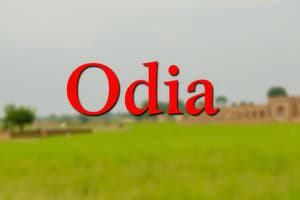Podcast
Questions and Answers
Which statement accurately describes the script used for writing the Odia language?
Which statement accurately describes the script used for writing the Odia language?
- The script has a linear form and consists of 12 vowels and 30 consonants.
- The script is an abugida with a circular shape, comprising 11 vowels and 36 consonants. (correct)
- The script is ideographic with 15 vowels and 40 consonants.
- The script is primarily based on the Latin alphabet and consists of 10 vowels and 25 consonants.
What is the primary sentence structure of the Odia language?
What is the primary sentence structure of the Odia language?
- Subject-Verb-Object (SVO) order.
- Subject-Object-Verb (SOV) order. (correct)
- Object-Subject-Verb (OSV) order.
- Verb-Subject-Object (VSO) order.
Which of the following statements about the dialects of Odia is NOT true?
Which of the following statements about the dialects of Odia is NOT true?
- Sambalpuri and Ganjami are examples of dialects from different countries. (correct)
- Different dialects exist across various districts in Odisha.
- Bhasha refers to regional variations of the language.
- Standard Odia is utilized in educational institutions.
What characterizes the vowel system in the Odia language?
What characterizes the vowel system in the Odia language?
Which statement regarding the cultural significance of the Odia language is accurate?
Which statement regarding the cultural significance of the Odia language is accurate?
Flashcards are hidden until you start studying
Study Notes
Overview of Odia Language
- Language Family: Odia is an Indo-Aryan language.
- Region: Primarily spoken in the Indian state of Odisha.
- Speakers: Over 40 million speakers, making it one of the major languages in India.
Script
- Writing System: Odia is written in the Odia script, which is an abugida.
- Characteristics: The script has a circular shape and consists of 11 vowels and 36 consonants.
Dialects
- Main Dialects:
- Standard Odia (used in education and media)
- Bhasha (regional variations)
- Different dialects across districts like Sambalpuri, Ganjami, and others.
Phonetics
- Vowels: 11 vowels, each has a short and long form.
- Consonants: 36 consonants with distinct pronunciation rules.
Grammar
- Sentence Structure: Subject-Object-Verb (SOV) order.
- Nouns: Gendered (masculine, feminine, neuter) with singular and plural forms.
- Pronouns: Vary based on formality and number (singular/plural).
Vocabulary
- Loanwords: Contains words borrowed from Sanskrit, Persian, and English.
- Word Formation: Frequent use of compound words and affixes.
Literature
- Literary Tradition: Rich history dating back to the 14th century.
- Prominent Writers: Includes poets like Sarala Das and modern authors like Fakir Mohan Senapati.
Cultural Significance
- Folklore and Mythology: Integral in Odia culture, with stories that influence art, dance, and music.
- Festivals: Language plays a crucial role in celebrations like Raja, Nuakhai, and Dussehra.
Official Status
- Recognition: Odia is recognized as one of the classical languages of India.
- Government Policy: Used in administration, education, and media in Odisha.
Learning Resources
- Books: Language textbooks and literature for learners.
- Online Courses: Various platforms offer Odia language courses for beginners.
- Community: Local language clubs and groups for practice and immersion.
Overview of Odia Language
- Odia is classified as an Indo-Aryan language.
- Spoken mainly in the Indian state of Odisha.
- Approximately 40 million speakers, making it one of India's prominent languages.
Script
- Utilizes the Odia script, characterized as an abugida.
- The script features a circular design, incorporating 11 vowels and 36 consonants.
Dialects
- Standard Odia is the formal version used in education and media.
- Regional dialects include variations known as Bhasha, with diverse forms across districts.
- Notable dialects are Sambalpuri and Ganjami.
Phonetics
- Contains 11 vowels, each having both short and long variations.
- Features 36 consonants, each following specific pronunciation rules.
Grammar
- Follows a Subject-Object-Verb (SOV) structure in sentence formation.
- Nouns are gendered (masculine, feminine, neuter) and marked for singular/plural forms.
- Pronouns differ based on level of formality and whether they are singular or plural.
Vocabulary
- Incorporates loanwords from Sanskrit, Persian, and English.
- Employs compound words and various affixes for word formation.
Literature
- Boasts a rich literary tradition that dates back to the 14th century.
- Notable writers include Sarala Das from the historical period and modern author Fakir Mohan Senapati.
Cultural Significance
- Folklore and mythology are integral to Odia culture, influencing various art forms, dance, and music.
- Language plays a vital role in local celebrations and festivals such as Raja, Nuakhai, and Dussehra.
Official Status
- Recognized as one of India's classical languages, highlighting its historical and cultural importance.
- Utilized in administration, education, and various media outlets throughout Odisha.
Learning Resources
- Availability of language textbooks and literature tailored for learners.
- Online platforms providing courses for beginners to learn Odia.
- Local clubs and groups encourage practice and immersion in the language.
Studying That Suits You
Use AI to generate personalized quizzes and flashcards to suit your learning preferences.




